Discover the 12 best influencer marketing platforms for 2025. In-depth reviews to help publishers find the right tool for campaign success and ROI.
In This Article
Subscribe to our newsletter
In 2025, influencer marketing has become a core component of sophisticated digital publishing strategy. For media teams, navigating the vast landscape of creator collaborations requires more than manual tracking in spreadsheets. The right technology is essential to discover authentic partners, manage complex campaigns, measure true ROI, and scale operations effectively. This shift from ad-hoc projects to integrated programs is precisely where dedicated influencer marketing platforms become indispensable, solving the critical challenges of workflow inefficiency and performance attribution.
This guide moves beyond surface-level lists to provide an in-depth analysis of the top tools, specifically tailored for the needs of modern publishers. We cut through the marketing jargon to deliver a comprehensive resource, evaluating platforms like Sprout Social, GRIN, and Upfluence. You'll get an honest assessment of each solution's unique strengths, critical limitations, and ideal use cases. This will empower you to select a platform that aligns with your strategic goals, whether you're focused on driving affiliate revenue, boosting brand engagement, or managing large-scale creator relationships.
Each entry includes detailed feature breakdowns, screenshots, and direct links to help you make an informed decision. To truly master creator partnerships, publishers should also equip themselves with diverse tools beyond just discovery platforms. For instance, exploring the top interactive video software can provide innovative ways to repurpose creator content and boost viewer engagement on your own properties. Our goal is to equip your team with the insights needed to find the perfect software stack, turning creator partnerships into a predictable and scalable channel for growth.
1. Sprout Social Influencer Marketing (formerly Tagger)
Sprout Social's Influencer Marketing hub, which fully integrated the powerful Tagger platform, stands out by unifying influencer campaign management with broader social media strategy. This integration allows media teams to move seamlessly from creator discovery and campaign execution to monitoring overall brand presence from a single, cohesive dashboard. It’s an ideal solution for publishers and brands that need to connect their influencer efforts directly to core social media performance metrics, eliminating the data silos common with standalone tools.
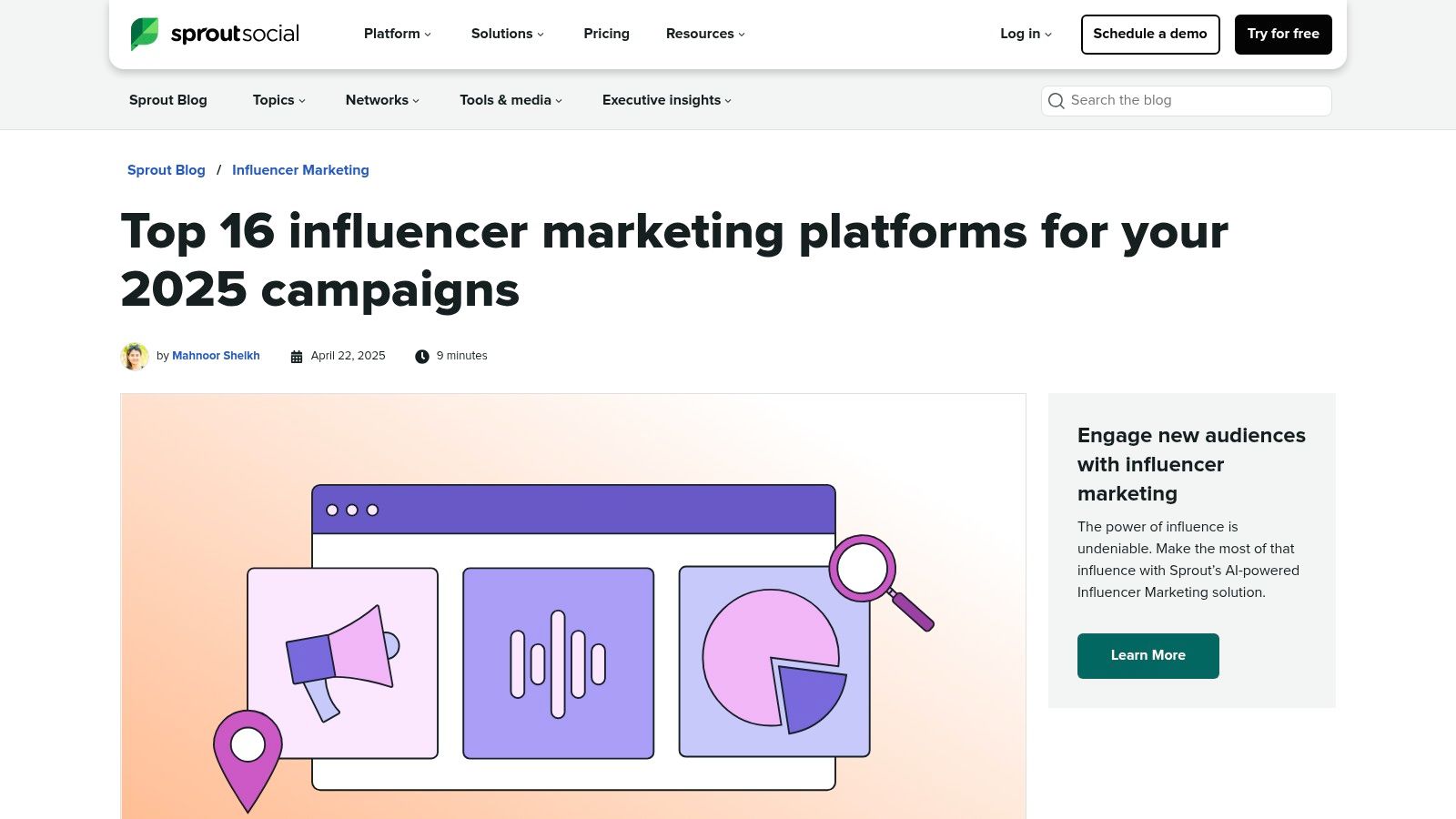
Unlike many influencer marketing platforms that exist in a vacuum, Sprout Social’s strength lies in its ecosystem. You can manage influencer relationships, track campaign ROI, and schedule your organic social posts without toggling between applications. This creates a powerful feedback loop where insights from influencer campaigns can directly inform your content calendar, and vice-versa.
Key Differentiators & Use Cases
The platform excels in data-driven decision-making. Its AI-powered discovery engine features a "Brand Fit Score" that goes beyond follower counts to analyze an influencer’s audience demographics, content style, and past brand collaborations, ensuring authentic alignment. For publishers, this means quickly identifying creators whose audience mirrors their target readership.
- Best For: Media companies and enterprise-level e-commerce teams seeking an all-in-one social and influencer management solution.
- Practical Tip: Leverage the brand safety reports during the vetting process. These reports scan a creator's historical content for red flags, helping you mitigate risk before committing to a partnership.
- Limitation: The platform’s comprehensive nature comes with a steeper learning curve for teams unfamiliar with advanced social analytics. The pricing structure, which is customized and not publicly listed, is generally geared toward mid-market to enterprise clients, potentially making it inaccessible for smaller businesses or solo publishers.
Website: https://sproutsocial.com/insights/influencer-marketing-platforms/
2. Upfluence
Upfluence distinguishes itself as one of the premier influencer marketing platforms by deeply integrating with e-commerce ecosystems, making it a powerhouse for brands focused on product seeding and affiliate sales. Its AI-driven technology streamlines the entire campaign lifecycle, from discovering hyper-relevant creators within its massive database to managing payments and tracking sales generated directly from influencer content. This direct link between outreach and revenue attribution is its core strength.
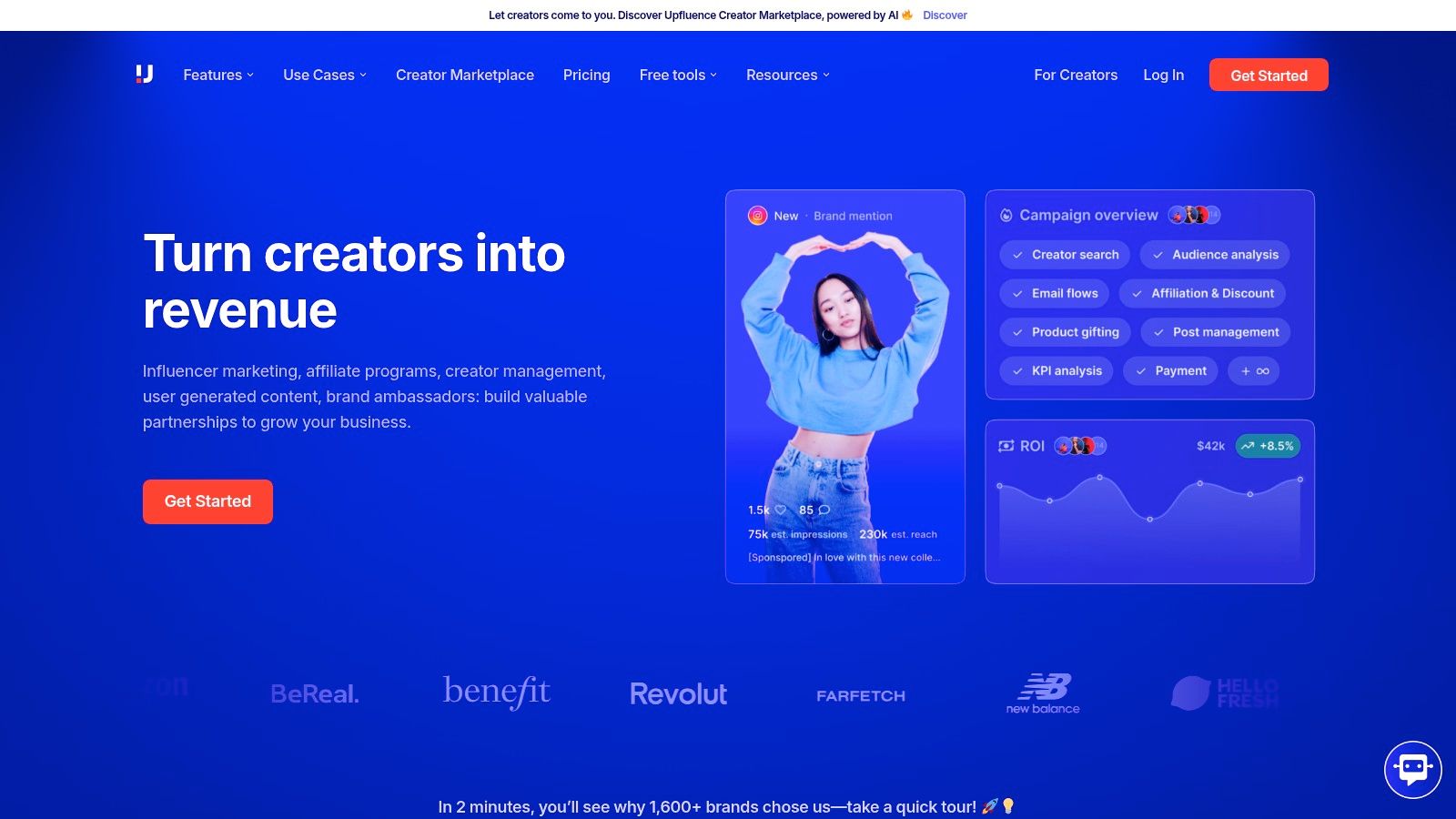
Unlike platforms that only focus on brand awareness, Upfluence offers tangible e-commerce tools like unique discount code generation and affiliate link tracking. This allows publishers and brands to build performance-based partnerships where creators are compensated based on the sales they drive. The platform's built-in CRM also helps teams nurture long-term relationships, turning one-off collaborations into a scalable community of brand advocates. These features are critical for building effective social media engagement strategies. For more information, you can learn more about boosting your brand on project-aeon.com.
Key Differentiators & Use Cases
The platform's native integration with Shopify and WooCommerce is a significant differentiator, allowing brands to identify influential customers directly from their own sales data. This "customer-first" approach helps uncover authentic advocates who already love the brand, leading to more genuine and effective partnerships.
- Best For: E-commerce brands, direct-to-consumer companies, and publishers with an affiliate marketing model looking to drive direct sales.
- Practical Tip: Use the Chrome extension, Upfluence Live, to analyze any influencer's profile directly from your browser across platforms like Instagram, TikTok, and YouTube. This allows for quick, on-the-fly vetting without having to switch back to the main dashboard.
- Limitation: The platform's feature set can be overwhelming for beginners, and its pricing structure is generally suited for established businesses rather than startups or small publishers. The powerful automated outreach tools require careful setup to avoid sounding generic.
Website: https://www.upfluence.com/
3. GRIN
GRIN positions itself as a creator management platform built specifically for the operational needs of direct-to-consumer (DTC) e-commerce brands. Its core philosophy revolves around managing authentic, long-term creator relationships rather than facilitating one-off transactional campaigns. The platform deeply integrates with e-commerce systems like Shopify, Magento, and WooCommerce, allowing brands to manage product seeding, affiliate payments, and discount codes directly from one central hub, tying creator activity directly to sales.
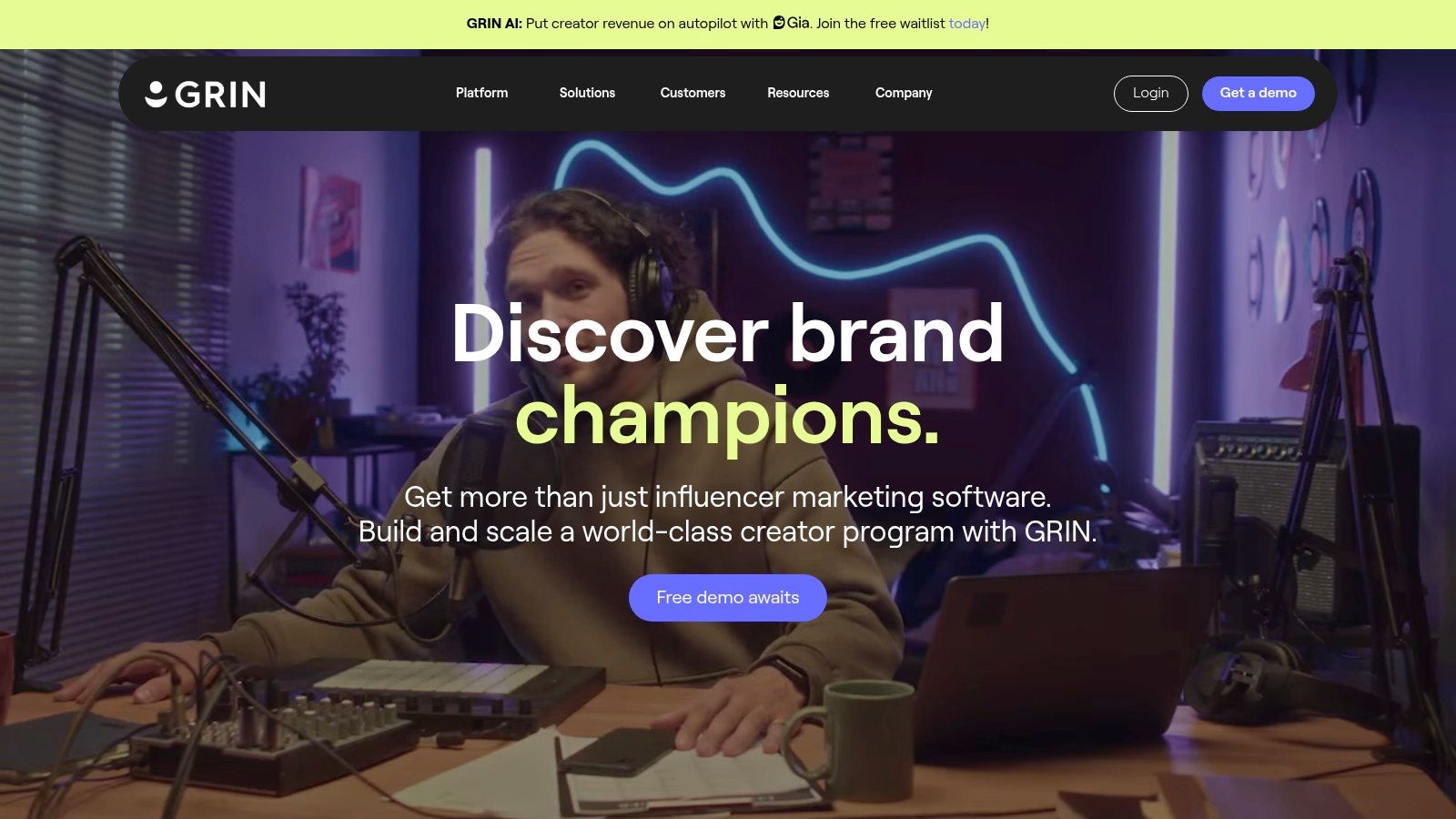
Unlike many other influencer marketing platforms that scrape public data, GRIN helps you build your own private network of creators. It focuses on finding influencers who are already authentic fans of your brand by analyzing your e-commerce customer lists, social media followers, and inbound applications. This "look-inward" approach is designed to foster more genuine partnerships that resonate with audiences and drive measurable conversions.
Key Differentiators & Use Cases
GRIN’s primary strength is its end-to-end workflow automation for product-centric collaborations. It streamlines the entire process from sending initial outreach emails and shipping products to collecting user-generated content and tracking sales. The platform’s ability to pull sales data directly from your e-commerce store provides one of the clearest ROI pictures in the industry.
- Best For: E-commerce teams and DTC brands that prioritize product seeding and affiliate marketing as their core influencer strategy.
- Practical Tip: Use the content management system to create detailed lookbooks of approved creator content. This centralizes assets, making it easy for your social media and ad teams to repurpose high-performing UGC for other marketing channels.
- Limitation: The platform’s robust feature set is geared toward established brands and comes with a premium price tag, which may be prohibitive for small businesses. Because it doesn’t have a searchable database of scraped influencers, it's less suited for brands focused purely on mass discovery of new talent outside their existing community.
Website: https://grin.co/
4. LTK (formerly rewardStyle)
LTK, which evolved from the affiliate network rewardStyle, is a powerhouse for brands focused on the lifestyle sector. It distinguishes itself by cultivating an exclusive, application-only network of creators primarily in fashion, beauty, home, and travel. This curated approach ensures brands connect with high-performing influencers who have a proven track record of driving conversions, making it one of the most effective influencer marketing platforms for consumer-facing product companies.
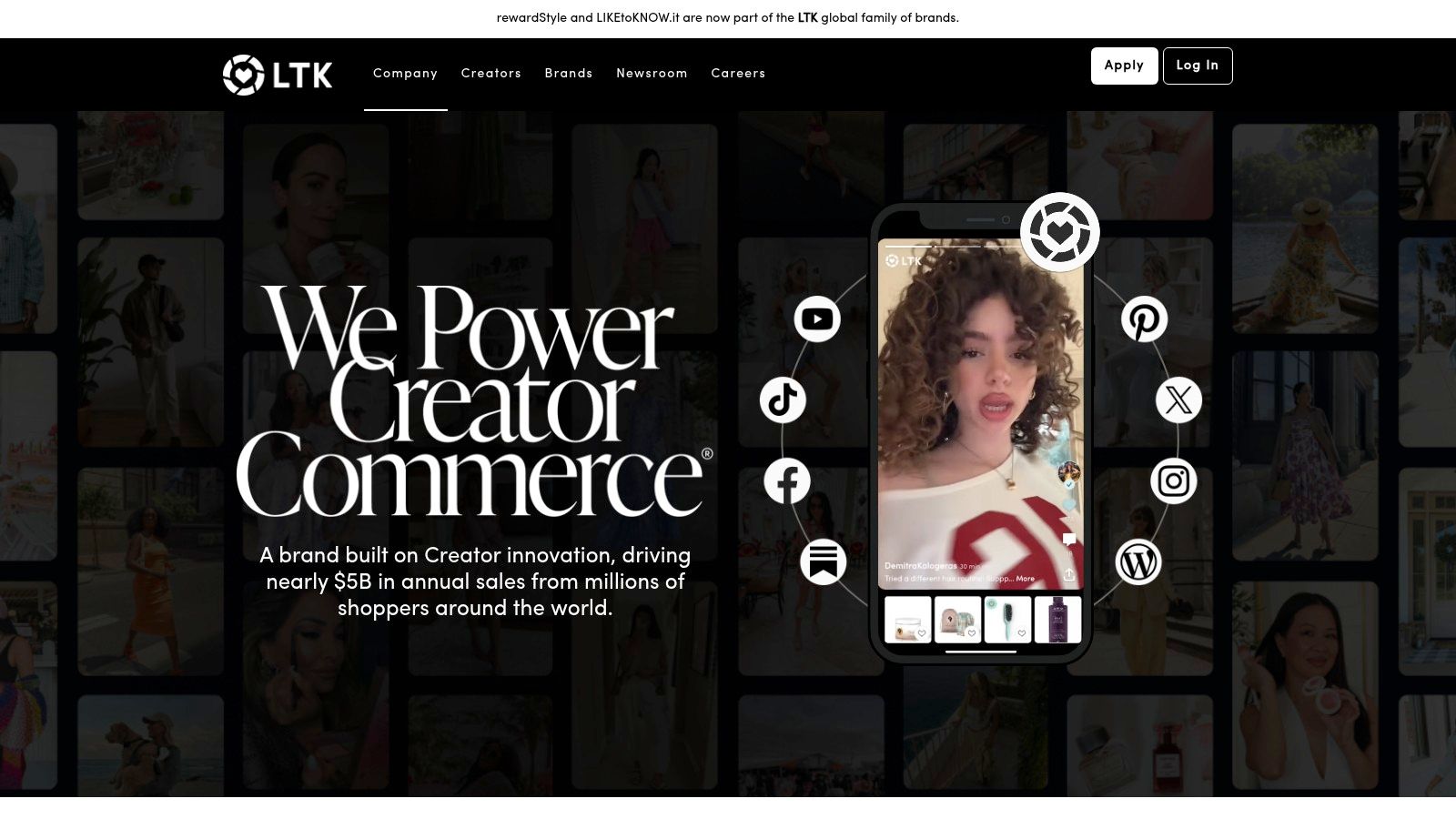
The platform is built around a performance-based model, where influencers earn commissions on sales they generate through trackable links and shoppable content. This aligns creator incentives directly with brand sales goals. For media companies looking to monetize their content, this model is particularly relevant, showing how media publishers are becoming e-commerce powerhouses by integrating affiliate marketing into their editorial strategies.
Key Differentiators & Use Cases
LTK's primary strength is its direct line to sales-driven performance. The platform provides robust analytics that track clicks, conversions, and revenue, offering clear ROI measurement. Its campaign management tools, content review workflows, and secure payment processing streamline the entire collaboration process from start to finish.
- Best For: E-commerce brands and media publishers in the fashion, beauty, and home decor niches seeking to drive direct sales through influencer content.
- Practical Tip: When evaluating creators on LTK, pay close attention to their historical sales data and conversion rates, not just their follower count. This data is a core part of the platform and a more reliable indicator of potential ROI.
- Limitation: The platform's highly curated and niche focus means it's not a fit for brands outside of mainstream lifestyle categories. Pricing is tailored to each brand and requires a direct inquiry, which may be a barrier for smaller businesses looking for transparent, entry-level options.
Website: https://company.shopltk.com/
5. Collabstr
Collabstr operates as an open influencer marketplace, distinguishing itself by simplifying the process of finding and hiring creators on a per-project basis. Unlike subscription-based influencer marketing platforms, its model is built on transactional ease, making it highly accessible for teams wanting to test the waters of influencer marketing or execute one-off campaigns without long-term financial commitment. The platform streamlines everything from discovery and negotiation to secure payments and content delivery.
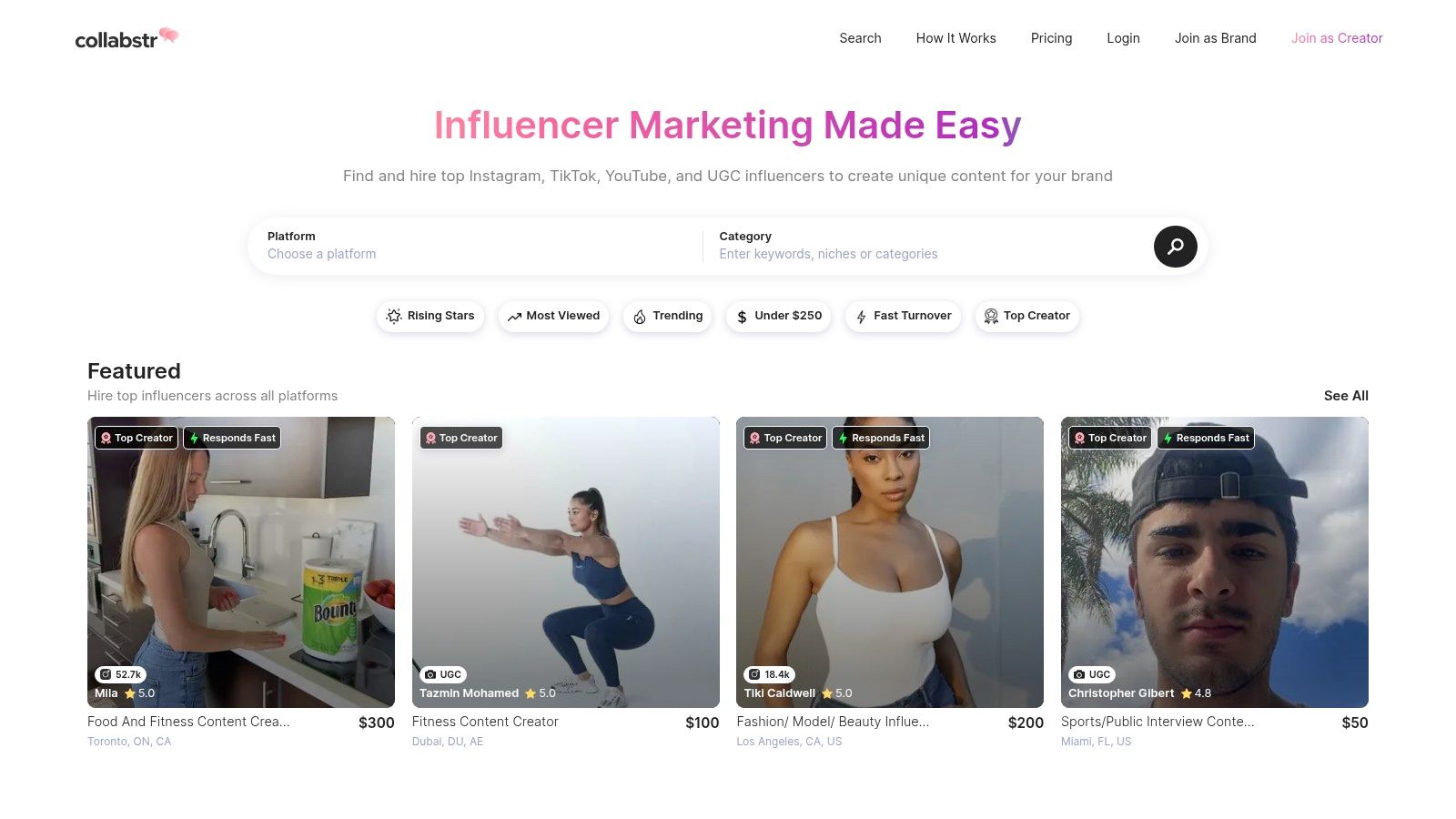
The platform's core strength is its transparency and simplicity. Influencers list their services and rates upfront, eliminating the often lengthy and uncertain negotiation process. For media teams or e-commerce brands needing quick-turnaround content or product placements, this direct, no-frills approach is a significant advantage. The integrated escrow service holds payments securely until the creator delivers the agreed-upon content, mitigating financial risk for both parties.
Key Differentiators & Use Cases
Collabstr excels in speed and efficiency for smaller-scale activations. Its powerful search filters allow you to quickly find creators by niche, location, follower count, and engagement rate, making it easy to identify relevant talent for targeted campaigns. The direct messaging system keeps all communication centralized and documented within the platform.
- Best For: Small to mid-sized businesses, e-commerce brands, and editorial teams looking for a pay-as-you-go solution for specific campaigns or content needs.
- Practical Tip: Use the platform to source user-generated content (UGC) at scale. You can hire multiple micro-influencers for a fixed, transparent price to generate authentic visuals and testimonials for your ad campaigns or social feeds.
- Limitation: The platform's analytics capabilities are not as deep as enterprise-level solutions. While you can see basic performance metrics, teams requiring in-depth ROI tracking, audience analysis, or competitor benchmarking may find it lacking. Your selection is also confined to the influencers who have actively created a profile on Collabstr.
Website: https://collabstr.com/
6. CreatorIQ
CreatorIQ positions itself as the central nervous system for creator-led marketing at the enterprise level. It is built for global brands and large media companies managing complex, high-volume campaigns, providing a system of record that integrates deeply into an organization’s existing marketing technology stack. The platform’s core philosophy is to move beyond transactional influencer relationships and build authentic, long-term creator partnerships at scale.
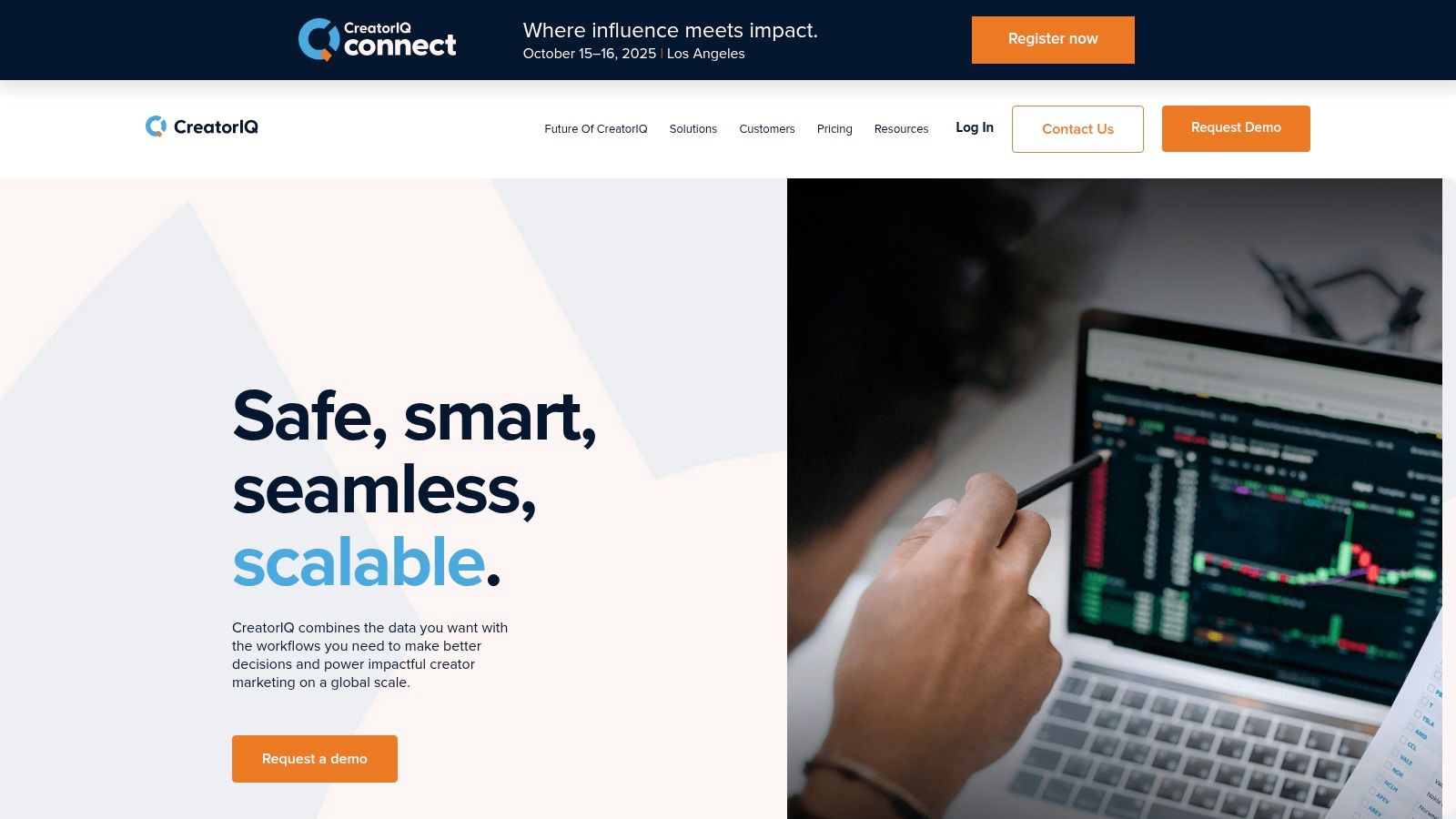
This platform isn't just another discovery tool; it's an end-to-end management solution designed for sophistication and control. It allows teams to consolidate influencer data, manage contracts and payments, and measure campaign performance against specific business objectives, all within a unified interface. CreatorIQ is one of the more robust influencer marketing platforms available, prioritizing data integrity and security for its high-profile clientele.
Key Differentiators & Use Cases
CreatorIQ’s primary strength is its powerful, AI-driven discovery and vetting process. The platform analyzes over 1 billion social accounts and provides an "Integrity Score" to flag potential fraud, like fake followers or engagement pods, ensuring investment is directed toward genuine influence. Its ability to integrate with tools like G-Suite, Slack, and major business intelligence platforms makes it a true enterprise solution.
- Best For: Large media conglomerates and global brands that require a scalable, secure, and data-rich platform to manage hundreds or thousands of creator relationships.
- Practical Tip: Use the platform’s private creator CRM to build a proprietary network of trusted influencers. This allows you to nurture relationships and reactivate high-performing creators for future campaigns without starting your search from scratch.
- Limitation: The platform’s enterprise focus means its pricing is at the higher end of the market, making it inaccessible for small businesses or startups. Its comprehensive feature set also necessitates dedicated training and onboarding to use effectively, which can be a hurdle for smaller, less-resourced teams.
Website: https://creatoriq.com/
7. Traackr
Traackr positions itself as a system of record for data-driven influencer marketing, focusing on long-term relationships over transactional campaigns. It’s designed for brands and publishers that view creators as strategic partners, providing deep analytics to discover, validate, and measure impact. The platform moves beyond vanity metrics to assess an influencer’s true reach and resonance, ensuring partnerships are built on genuine audience connection rather than just follower counts.
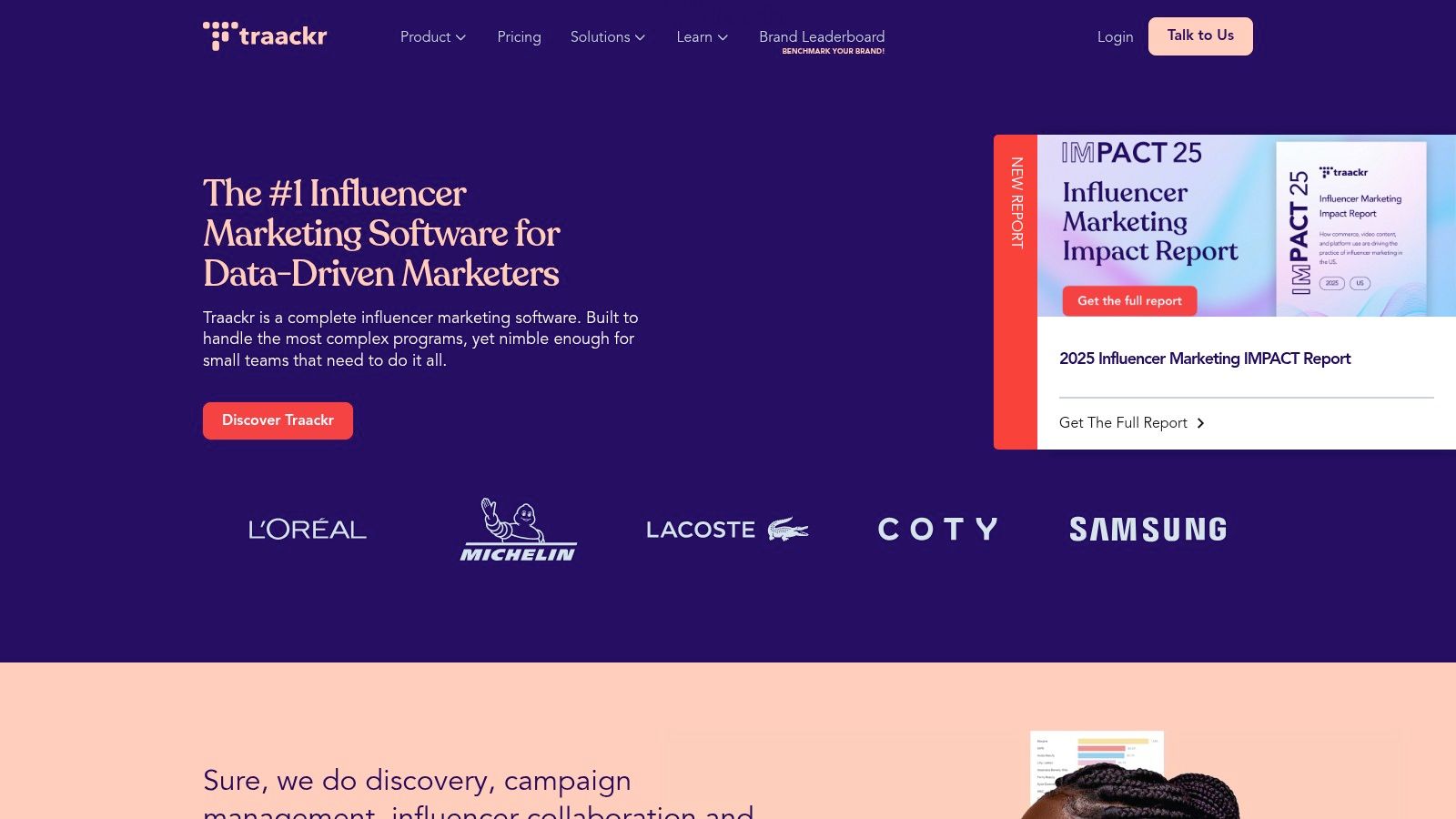
Its strength lies in its sophisticated relationship management and performance benchmarking tools. Traackr allows teams to manage large networks of influencers, track historical performance, and compare their program’s success against competitors. This approach supports the growing industry shift toward more authentic, creator-driven direct partnerships. This focus makes it one of the more robust influencer marketing platforms for establishing and scaling an ambassador program.
Key Differentiators & Use Cases
Traackr’s analytics are a key differentiator, offering customizable dashboards that track everything from brand mentions to cost efficiency (VIT or Value per $1K Spent). This allows media teams to prove ROI with granular data that ties influencer activity directly to business outcomes.
- Best For: Global enterprises and established brands in sectors like beauty, fashion, and tech that need to manage and scale long-term, multi-market influencer programs.
- Practical Tip: Use the competitive benchmarking feature to identify creators working with rival publishers or brands. This can reveal untapped talent or highlight which partnerships are driving the most engagement in your niche.
- Limitation: The platform’s advanced capabilities and enterprise focus mean its pricing is at the higher end of the market, which can be prohibitive for smaller businesses. The depth of data can also present a significant learning curve for teams not accustomed to advanced analytics.
Website: https://www.traackr.com/
8. Modash
Modash is a streamlined yet powerful influencer marketing platform focused on delivering accurate, actionable data for Instagram, YouTube, and TikTok. It carves out its niche by offering one of the most comprehensive and up-to-date influencer databases on the market, claiming to list every creator on these platforms with over 1,000 followers. This makes it an invaluable tool for teams that need to conduct highly specific, data-driven discovery without the enterprise-level overhead of more complex suites.
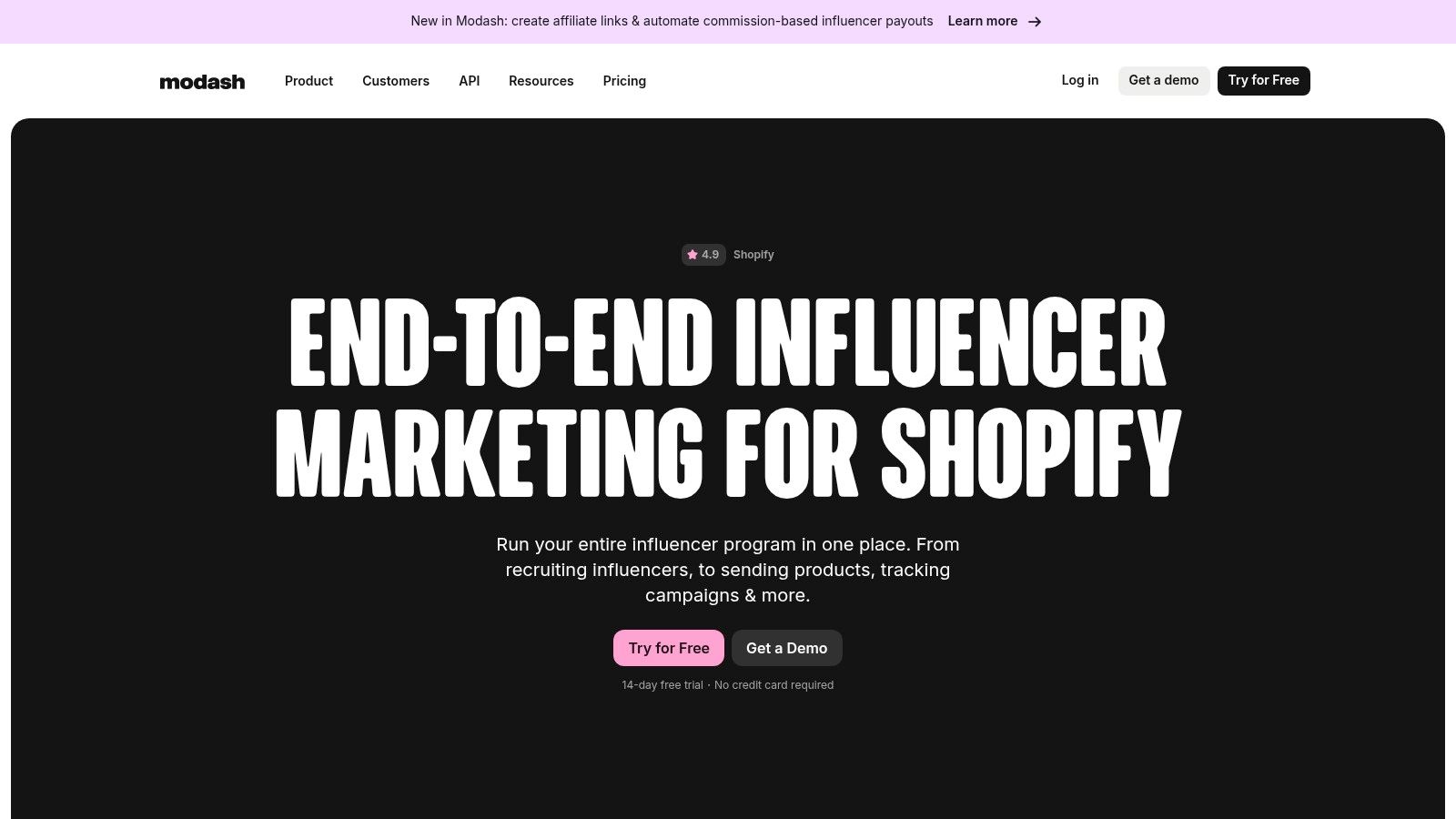
The platform’s core strength is its no-nonsense approach to discovery and analysis. Instead of bundling features like payments or contract management, Modash hones in on finding the right influencers and verifying their audience quality. Its interface is clean and user-friendly, allowing teams to quickly apply granular filters like audience location, keywords in bio, engagement rate, and even lookalike audiences, then export lists for direct outreach.
Key Differentiators & Use Cases
Modash excels at providing raw, reliable data that empowers manual outreach strategies. Its fake follower detection is a standout feature, giving media teams confidence that they are investing in creators with genuine engagement. The platform’s flexible pricing, including a credit-based system for analytics reports and a free trial, makes it accessible for teams of all sizes, from small publishers testing the waters to large agencies running scaled campaigns.
- Best For: Marketing teams and publishers of all sizes who prioritize data-rich influencer discovery and vetting over all-in-one campaign management.
- Practical Tip: Use the "Audience Lookalikes" feature to find new creators. If you have an influencer who performs well, you can input their handle to discover other creators with similar audience demographics and interests.
- Limitation: The platform is intentionally lean. It does not include built-in campaign management, outreach, or payment processing tools. Teams will need to use separate systems for these tasks, which can be a drawback for those seeking a single-dashboard solution.
Website: https://www.modash.io/
9. Meltwater (formerly Klear)
Meltwater, having integrated the capabilities of Klear, positions its influencer marketing platform as a core component of a much larger media intelligence ecosystem. This makes it a powerhouse for brands and publishers who need to connect their creator partnerships with broader market trends, competitive analysis, and social listening. Instead of just managing campaigns, users can discover influencers based on real-time conversations and measure their impact against the brand's overall share of voice in the market.
The platform’s strength is its deep integration with comprehensive media monitoring. You can identify an emerging trend through social listening, find the key influencers driving that conversation, and then manage an entire campaign with them, all within the Meltwater suite. This holistic approach helps teams justify influencer spend by linking it directly to tangible brand health metrics, moving beyond simple engagement rates.
Key Differentiators & Use Cases
Meltwater excels at providing context. Its AI-driven influencer scores analyze not just audience size but also resonance and relevance within specific niches, helping identify true thought leaders. With a database of over 30 million profiles, its discovery tools are robust enough for global campaigns, allowing teams to find hyper-local creators or international stars with equal efficiency.
- Best For: Global brands and agencies that require integrated social listening and competitive intelligence alongside their influencer marketing platforms.
- Practical Tip: Use the platform’s "True Reach" metric during discovery. It helps differentiate influencers with genuinely engaged audiences from those with inflated follower counts composed largely of bots or inactive accounts.
- Limitation: The platform’s extensive feature set can be overwhelming for smaller teams focused solely on influencer outreach. Pricing is not publicly available and is tailored for enterprise-level clients, making it a significant investment that may not be suitable for businesses with limited budgets.
Website: https://www.meltwater.com/en/products/influencer-marketing
10. Brandwatch
Brandwatch stands out by deeply integrating its influencer marketing capabilities with its world-class social listening and consumer intelligence tools. This creates a powerful, unified platform where identifying the right creators is just the beginning. Media teams can move from understanding audience conversations and brand sentiment directly to activating influencers who are already part of those discussions, ensuring campaigns are not just placed but are contextually relevant and impactful.
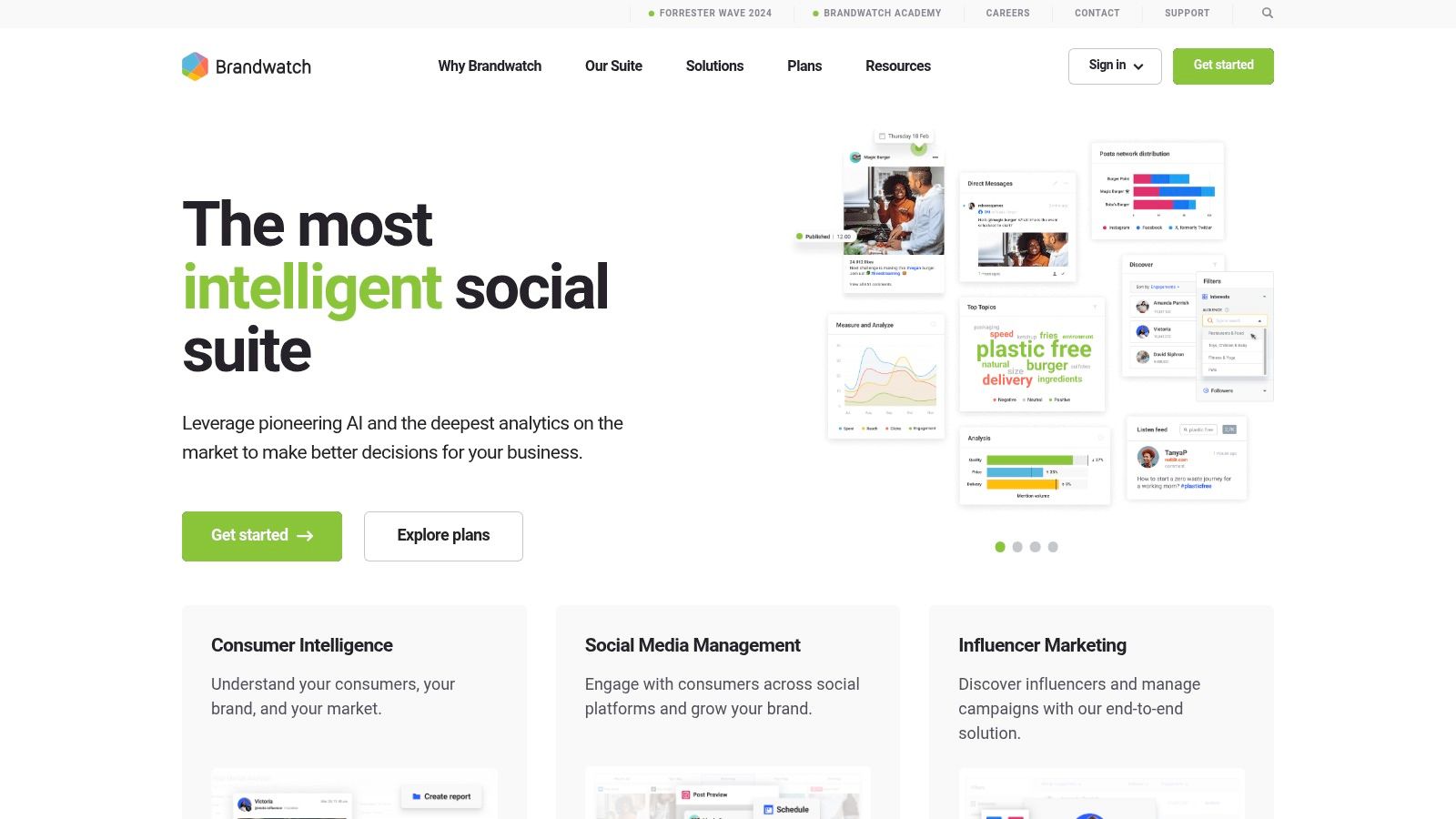
Unlike many influencer marketing platforms that focus solely on creator metrics, Brandwatch connects influencer performance to broader market trends. Publishers can use it to discover which influencers are driving conversations about topics relevant to their editorial calendar, then recruit them for campaigns. This strategic approach transforms influencer marketing from a siloed activity into a core component of audience and brand strategy, backed by robust analytics.
Key Differentiators & Use Cases
Brandwatch’s strength is its massive dataset and the analytical power to make sense of it. With access to over 30 million creators, its discovery engine allows for incredibly granular filtering, but its real power is in the qualitative analysis. You can track not just an influencer's reach but the sentiment and context of their audience's conversations, offering a much deeper layer of vetting.
- Best For: Enterprise-level brands and large media companies that require a holistic view of their market, competitors, and influencer landscape in one platform.
- Practical Tip: Use the social listening integration to set up alerts for your brand or key topics. This helps you discover emerging micro-influencers who are organically talking about your niche, providing a steady stream of authentic partnership opportunities.
- Limitation: The platform's immense power and complexity come with a significant learning curve and a premium price tag, making it less suitable for smaller businesses or teams without dedicated analysts. The sheer volume of data can be overwhelming if you don't have a clear strategy.
Website: https://www.brandwatch.com/
11. Afluencer
Afluencer operates as a dynamic influencer marketplace designed to connect brands directly with a growing community of creators. It streamlines the collaboration process by allowing businesses to post "Collabs," which are essentially campaign briefs that influencers can apply for. This reverses the typical search-and-outreach model, making it an efficient way for brands with compelling offers to attract interested talent without extensive manual searching.

Unlike enterprise-level influencer marketing platforms that require hefty subscriptions, Afluencer provides a more accessible, a-la-carte approach suitable for businesses of all sizes, including small publishers and e-commerce startups. Its strength lies in its simplicity and user-friendly interface, which centralizes communication, proposals, and campaign management in a single dashboard, removing the complexity often associated with larger systems.
Key Differentiators & Use Cases
The platform's primary differentiator is its "Collab" feature, which empowers brands to create public listings detailing their campaign goals, requirements, and compensation. This turns the discovery process into an inbound funnel, saving time for marketing teams. Its search functionality also includes filters for niche, platform, and audience size, enabling targeted outreach when a more proactive approach is needed.
- Best For: Small to medium-sized businesses, e-commerce brands, and publishers looking for a straightforward, cost-effective way to find and manage influencer collaborations.
- Practical Tip: When posting a "Collab," be extremely specific about your ideal creator and campaign deliverables. The clearer your brief, the higher the quality of applicants you will attract, minimizing time spent vetting irrelevant profiles.
- Limitation: Afluencer's influencer pool is limited to those who have signed up for the platform, which may not include every top-tier creator in a specific niche. Its analytics are also more foundational compared to comprehensive platforms, focusing on essential performance metrics rather than deep audience psychographics.
Website: https://afluencer.com/
12. Pearpop
Pearpop positions itself as a "creator collaboration marketplace," distinguishing itself from traditional influencer marketing platforms by focusing on speed, direct access, and performance-based activations. It operates more like a social stock market for influence, where brands can instantly launch "challenges" that creators can opt into, democratizing access and removing lengthy negotiation cycles. This model is built for agile marketing teams that need to react quickly to cultural moments or launch campaigns on short notice.
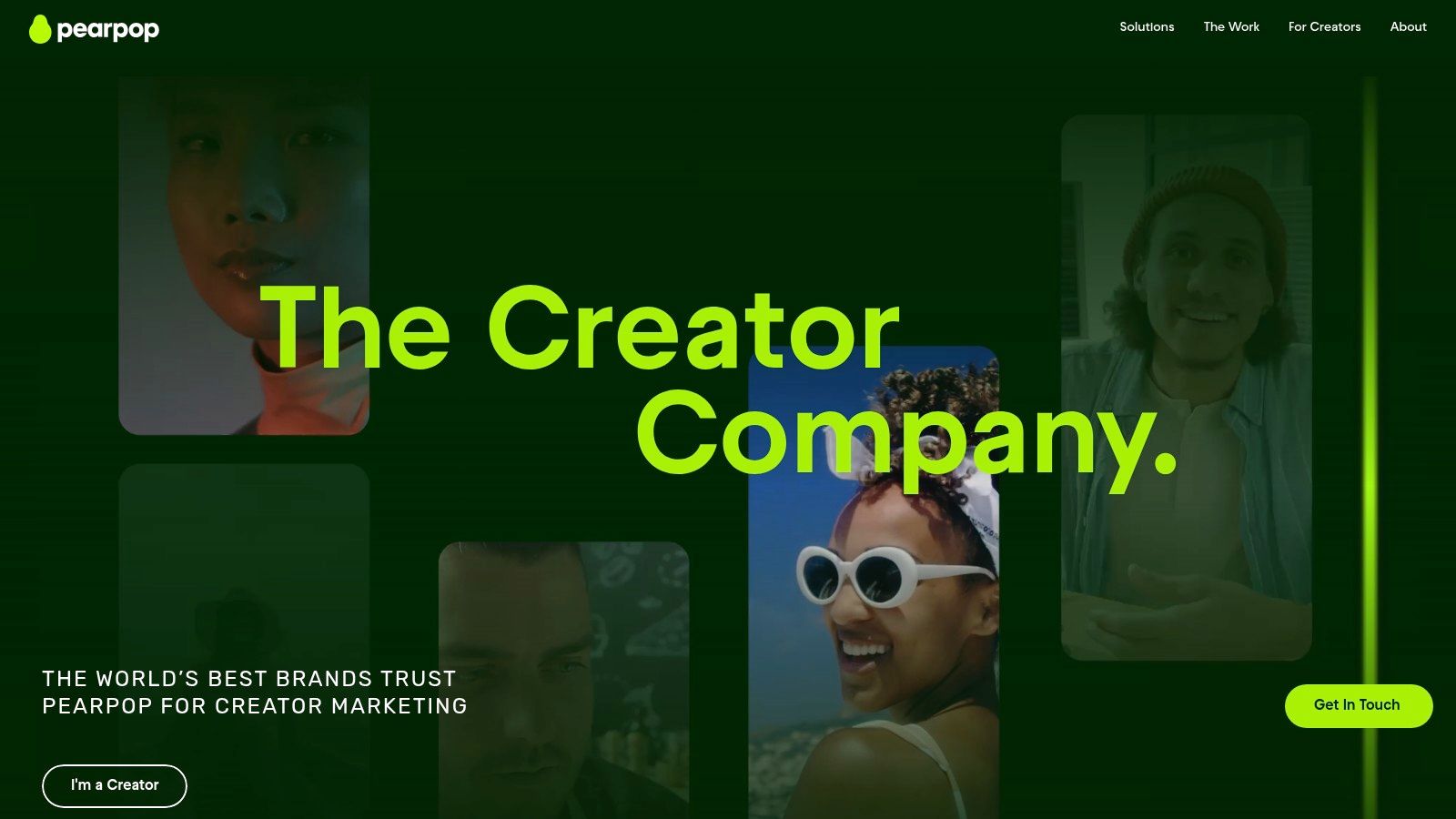
The platform's core strength is its instant activation feature, which allows a brand to set a budget and campaign goal, then watch as creators from TikTok, Instagram, and other networks join in. This approach gamifies the campaign process and flips the traditional discovery model on its head; instead of searching for creators, brands broadcast an opportunity and let interested creators come to them.
Key Differentiators & Use Cases
Pearpop’s most unique feature is its pay-for-performance compensation model. Brands often pay based on engagement metrics like views or likes, directly tying spend to results and minimizing the risk of paying high flat fees for underperforming content. This makes it highly efficient for campaigns focused on generating user-generated content (UGC) at scale or driving viral trends on platforms like TikTok.
- Best For: Brands and media companies focused on viral marketing, UGC campaigns, and rapid-fire activations on TikTok and Instagram.
- Practical Tip: Use the "challenge" feature to test creative concepts. By launching a small-scale, performance-based challenge, you can gather real-world data on which type of content resonates with audiences before committing a larger budget.
- Limitation: The platform’s self-serve, open-marketplace model offers less control over brand safety and creator selection compared to deeply vetted, managed-service platforms. While efficient, it may not be suitable for luxury brands or campaigns requiring strict messaging and aesthetic guidelines.
Website: https://pearpop.com/
Top 12 Influencer Marketing Platforms Comparison
| Platform | Core Features / Functionality | User Experience & Quality ★ | Value Proposition 💰 | Target Audience 👥 | Unique Selling Points ✨ |
|---|---|---|---|---|---|
| Sprout Social Influencer Marketing | AI influencer discovery, campaign & analytics | ★★★★ Streamlined workflows | 💰 Mid to High, scalable | 👥 Mid to large brands & agencies | 🏆 Brand Fit Score, integrated reports |
| Upfluence | AI influencer database, outreach, e-commerce tools | ★★★★ Automated workflows | 💰 Mid to High | 👥 E-commerce brands, marketers | ✨ E-commerce integration, AI outreach |
| GRIN | E-commerce focus, campaign & relationship mgmt | ★★★★ Robust integrations | 💰 Higher for SMBs | 👥 E-commerce & brands | 🏆 Shopify integration, social listening |
| LTK | Vetted lifestyle influencers, campaign mgmt | ★★★★ High-quality network | 💰 Custom pricing (upon inquiry) | 👥 Lifestyle & fashion brands | ✨ Exclusive vetted influencers |
| Collabstr | Influencer marketplace, pay-per-collab | ★★★ Easy & transparent | 💰 Pay per collaboration | 👥 Small to medium businesses | ✨ No subscription fee, escrow payment |
| CreatorIQ | AI discovery, fraud detection, enterprise workflows | ★★★★★ Enterprise-grade | 💰 High, enterprise level | 👥 Large global brands | 🏆 Fraud detection, deep analytics |
| Traackr | Influencer discovery, relationship mgmt | ★★★★ Data-driven & authentic | 💰 High pricing | 👥 Large influencer networks | ✨ Authentic partnerships focus |
| Modash | Influencer discovery (Insta/YT/TikTok), performance | ★★★★ User-friendly, strong search | 💰 Affordable & scalable | 👥 SMBs & all-size businesses | ✨ Fake follower detection |
| Meltwater | AI discovery, social listening, ROI tracking | ★★★★ Robust analytics | 💰 Custom pricing (inquiry) | 👥 Agencies & global brands | ✨ Media intelligence integration |
| Brandwatch | Influencer mgmt, social media monitoring integration | ★★★★ Comprehensive analytics | 💰 High pricing | 👥 Large-scale influencer campaigns | 🏆 Social monitoring integration |
| Afluencer | Influencer marketplace, campaign & tracking | ★★★★ Easy to use | 💰 Transparent pricing | 👥 SMBs & enterprises | ✨ Multiple platform support |
| Pearpop | Instant creator activation, pay-for-performance | ★★★★ Fast & efficient | 💰 Performance-based payment | 👥 Brands seeking quick campaigns | ✨ Instant activation, pay-per-performance |
Choosing the Right Platform to Scale Your Creator Strategy
Navigating the crowded landscape of influencer marketing platforms can feel overwhelming, but making an informed choice is the critical first step toward building a scalable and profitable creator program. As we've explored, the "best" platform is not a universal title but a designation specific to your team’s unique needs, operational scale, and strategic objectives.
The key takeaway is that moving beyond manual spreadsheets and disjointed communication is no longer optional; it's essential for survival and growth. For publishers and media companies, the right tool transforms influencer collaborations from a series of tactical, one-off campaigns into a cohesive, long-term strategy. It provides the infrastructure to discover authentic partners, manage complex relationships, measure true ROI, and ultimately, integrate creator-driven content seamlessly into your broader editorial and commercial ecosystem.
A Framework for Your Final Decision
Your final selection process should be a deliberate evaluation, not a quick glance at feature lists. Before committing to a platform, revisit your core goals. Are you a D2C brand focused on driving direct sales through affiliate links and authentic user-generated content? A platform like GRIN or LTK might be your ideal match. Are you a large enterprise or media publisher requiring deep analytics, brand safety controls, and multi-team collaboration? An end-to-end solution like CreatorIQ or Sprout Social is likely the right investment.
Consider these pivotal questions to guide your choice:
- What is our primary goal? Is it brand awareness (Traackr, Brandwatch), direct e-commerce sales (GRIN), content generation (Collabstr, Pearpop), or a mix of everything (Upfluence, CreatorIQ)?
- What is our team's capacity? Do we need an all-in-one platform with robust workflow automation, or is a self-service marketplace model like Collabstr or Afluencer sufficient for our current needs?
- How important is data and reporting? For teams that need to prove ROI to stakeholders, platforms with advanced attribution and analytics like Meltwater or Modash are non-negotiable.
- What is our budget reality? Be realistic. While enterprise solutions offer incredible power, their price point may be prohibitive. Evaluate if a more accessible tool can meet 80% of your needs effectively.
Implementation and Beyond: The Human Element
Remember, even the most sophisticated influencer marketing platforms are just tools; they don’t replace the need for genuine human connection. The technology should augment your strategy, not define it. Use these platforms to handle the administrative heavy lifting, such as discovery, outreach, and payment processing, so your team can focus on what truly matters: building authentic, lasting relationships with creators.
Once you have established these partnerships, the strategy evolves. The powerful content your creators produce is a valuable asset that needs to be leveraged across multiple channels. This is where a holistic content strategy becomes vital. Many teams are now exploring how to further engage audiences by transforming static content into dynamic experiences. In fact, learning how creators and businesses utilize top interactive video platforms for engagement can unlock new opportunities for repurposing influencer-generated content.
Ultimately, selecting the right platform is about empowering your team to work smarter, not harder. It’s about building a scalable foundation that supports your growth, proves the value of your creator partnerships, and frees up your team to foster the creativity that drives meaningful results.
Ready to amplify the incredible content your new creator partners produce? Aeon helps publishers and media teams transform influencer content into a high volume of engaging videos, extending the life and reach of every campaign. See how you can maximize your creator ROI by visiting Aeon today.


.jpg)